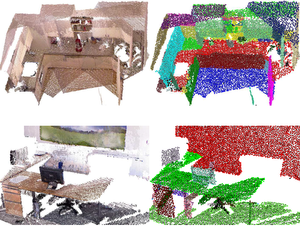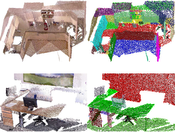Information
- Publication Type: Conference Paper
- Workgroup(s)/Project(s):
- Date: April 2012
- ISBN: 978-3-200-02588-2
- Location: Vienna
- Lecturer: Irene Reisner-Kollmann
- Booktitle: Proceedings of 19th International Conference on Systems, Signals and Image Processing (IWSSIP 2012)
- Conference date: 11. April 2012 – 13. April 2012
- Keywords: surface fitting, range data, segmentation, shape detection
Abstract
We introduce a novel method for automatically segmenting multiple registered range images by detecting and optimizing geometric primitives. The resulting shapes provide high level information about scanned objects and are a valuable input for surface reconstruction, hole filling, or shape analysis. We begin by generating a global graph of sample points covering all input frames. The graph structure allows to compute a globally consistent segmentation with a memory and time-efficient solution, even for large sets of input images. We iteratively detect shapes with a Ransac-approach, optimize the assignments of graph nodes to shapes, and optimize the shape parameters. Finally, pixel-accurate segmentations can be extracted for each source image individually. By using range images instead of unstructured point clouds as input, we can exploit additional information such as connectivity or varying precision of depth measurements.Additional Files and Images
Weblinks
No further information available.BibTeX
@inproceedings{reisner-2012-iwssip,
title = "Segmenting Multiple Range Images with Primitive Shapes",
author = "Irene Reisner-Kollmann and Stefan Maierhofer",
year = "2012",
abstract = "We introduce a novel method for automatically segmenting
multiple registered range images by detecting and optimizing
geometric primitives. The resulting shapes provide high
level information about scanned objects and are a valuable
input for surface reconstruction, hole filling, or shape
analysis. We begin by generating a global graph of sample
points covering all input frames. The graph structure allows
to compute a globally consistent segmentation with a memory
and time-efficient solution, even for large sets of input
images. We iteratively detect shapes with a Ransac-approach,
optimize the assignments of graph nodes to shapes, and
optimize the shape parameters. Finally, pixel-accurate
segmentations can be extracted for each source image
individually. By using range images instead of unstructured
point clouds as input, we can exploit additional information
such as connectivity or varying precision of depth
measurements.",
month = apr,
isbn = "978-3-200-02588-2",
location = "Vienna",
booktitle = "Proceedings of 19th International Conference on Systems,
Signals and Image Processing (IWSSIP 2012)",
keywords = "surface fitting, range data, segmentation, shape detection",
URL = "https://www.cg.tuwien.ac.at/research/publications/2012/reisner-2012-iwssip/",
}


